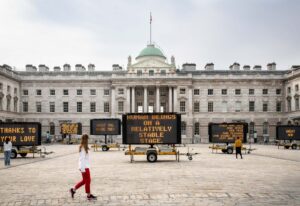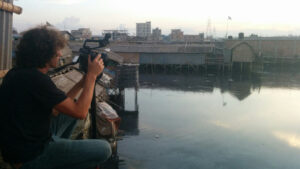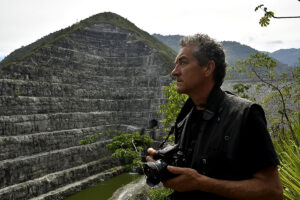
Justin Brice – Environmental Artist
Environmental artist Justin Brice encourages others to take a critical look at the relationship between humans and the planet.
France
Eva Baron May 14, 2021
In exploring the various intersections between textiles and natural landscapes, French fiber artist Edith Meusnier offers us a colorful vision into environmental consciousness. Drifting upon lakes or perched between tree branches, Meusnier’s textile sculptures root themselves within nature, reflecting Meusnier’s careful consideration of her surrounding environment. The artistic and naturalistic harmony achieved by Meusnier has earned her international acclaim, with her sculptures being showcased across Europe.
Throughout her artistic practice, Meusnier challenges the prominence of interior exhibitions, extending her work beyond the museum space and into outdoor environments. Displayed amongst trees, fields, parks, and courtyards, Meusnier’s sculptures contend with their essential ephemerality, as they are contingent upon the shifts in seasons and their site-specificity. Despite their impermanence, these sculptures grant Meusnier flexibility, allowing her to reside in or, at the very least, frequently visit the communities in which her art will be exhibited.
Mood of Living: Where are you from? Where did you grow up?
Edith Meusnier: I am French and I grew up in Paris.
MoL: Where are you currently based as an artist?
EM: For 25 years, I have been living in a small village situated in the clearing of a forest in Picardy, France.
MoL: What inspired you to become an artist?
EM: It is not the fruit of a decision but the result of a journey made of chances and meetings.
MoL: Where did you learn your craft?
EM: In books, at the Forney library in Paris. It is a magnificent place dedicated to crafts and decorative arts, and where I discovered the richness of pre-Columbian textiles, the diversity of myths, and symbols related to weaving. I then became fascinated with the study and contemporary interpretation of primitive plaiting, before completing this self-taught research by studying textile design at the National School of Industrial Design in Paris.
MoL: What drew you to textiles and fiber art as mediums?
EM: I have always appreciated the flexibility, lightness, and fluidity of textiles. I like to touch them, manipulate them, and transform them. Omnipresent throughout our daily life, like a second skin, they are the main intermediary between the intimate and the collective, which makes them the ideal medium to evoke the links we forge with each other, and to question the relationships we have with our environment.
MoL: What is the inspiration behind the colors you use for your pieces?
EM: When I plait threads and ribbons, I make the colors dance under my fingers before deploying them in places that are never neutral, but saturated with colors, shapes, and lines that change according to daily and seasonal variations. Colorful and transparent, my installations contrast before merging with the landscape into an unpredictable dialogue. Opaque in the shade, diaphanous in the sun, they undulate, divide the space or reveal it.
MoL: You work with a vast variety of materials, but which one has been your favorite and why?
EM: I divert synthetic fibers from their industrial or decorative uses to plait stretchy nets. Thanks to their elasticity and their resistance to bad weather, I make modular structures which I transform thereafter to carry out new installations. I thus offer an unusual image of materials that are said to be poor, but which are in fact very expensive in terms of ecology.
The gift ribbon is my favorite material: light, fluid, shimmering, joyful symbol of festive events and gift exchanges. However, cheap junk is very quickly thrown away and becomes the symbol of a consumerist drift. I rely on this ambivalence to create installations that seem paradoxical at first glance.
MoL: Why do you prefer for your work to be contingent upon shifts in seasons? What does the connection with the seasons mean for you?
EM: My work is linked to my living environment, which is punctuated by four particularly contrasting seasons in the forest. The trees become bare in winter; the colors, the light, but also the wind and the temperatures, the sounds and the smells vary throughout the year. I am very sensitive to these transformations which constantly renew my curiosity and are my main source of inspiration.
MoL: What does site-specificity mean to you?
EM: At first, it is a few details of a landscape that catch my attention during a walk. Once my interest is aroused, I return to the place to observe the changes caused by the intensity of sun or wind. It is according to these first impressions that I elaborate the project of a new installation. The interactions that take place between the site I have chosen and the artifact I have introduced in it do the work thereafter.
MoL: How has your understanding of the natural world been integrated into the art you create?
EM: The places in which I install my works have all been shaped or exploited by humans for centuries. I am interested in the more or less visible or harmful results of these interactions, and in the very porous borders they draw between the natural and the artificial in our current environment. I compose a fleeting staging of these vulnerable sites with installations that do not impose themselves in the landscape: they cross it without leaving any trace or causing any damage, like visual filters or temporal punctuations.
By exposing for more than twenty years very light textile works to bad weather, I have been able to measure concretely the multiplication of wind gusts, the alternation of periods of heat wave, drought, or torrential rains. As time went by, I was obliged to take these changes into account and to adapt my work to increasingly uncertain climatic conditions.
MoL: How do you get to know the communities in which you work? What does it mean to be so involved with a community and how does this impact your art?
EM: I work alone most of the year, and when I’m invited to an art residency, it’s an opportunity to break away from my daily routine. To conceive of and realize a new installation in an unknown place and in a limited time is a real challenge. To intervene in the life of the inhabitants, even temporarily, is not trivial. It is the encounters, the exchanges, the laughter, the moments shared, the help given, and even the criticism that transform the initial discomfort into a very stimulating context.
MoL: What can others do to lead more sustainable lives?
EM: The softness and comfort that textiles provide us with conceal an extremely polluting industry and disastrous working conditions for the workers in the sector. The pleasure we get from the beauty of a landscape or a starry sky hides the ravages caused by the overexploitation of natural resources and air pollution. Becoming aware of the paradoxical aspect of the world in which we live, and trying by all means to remedy the nuisances which alter our environment, constitute an indispensable first step, but the stakes involved go far beyond individual goodwill.
It will not be sufficient to stop a deadly mechanism of domination and exploitation which endangers the living world. Only a collective mobilization will have a chance to reverse this process.
MoL: How do you lead an eco-conscious life and how does this influence your art?
EM: I try to pursue a life in accordance with my ideas. I am fortunate to live in a place that I like and to do what I like. Thanks to these precious assets, I don’t feel the need to compensate for frustrations by compulsive over-consumption. My art reflects my tastes and choices. With ordinary materials, I take the time to handcraft light works that are very easy to transport. Most often, I install them near my home and I recycle them in successive installations.
MoL: How has your artistic process evolved during COVID? How has COVID impacted the way you understand nature as well as art?
EM: Most of my projects for 2020 and 2021 have been cancelled, though others keep getting postponed and the pace of my work has slowed down a lot. Obviously the COVID pandemic has revealed the dysfunctions of a planetary system that persists in increasing inequalities and destroying biodiversity, but I lack the hindsight and knowledge to measure the effects that COVID has on nature. Sadly, I have observed near my place that it has not stopped deforestation, on the contrary. As for the hunters, they took advantage of this period to multiply the illegal practices, transforming the forest into a vast livestock breeding and a sinister slaughterhouse in the open air.
Art, artistic practice, and the reception of works cover such vast domains that it is impossible for me to evaluate the consequences of COVID on art. I only know that many artists and art students have to face an increased precariousness, while in other spheres, a privileged few revel in the healthy art market.
Photography courtesy of Edith Meusnier

Environmental artist Justin Brice encourages others to take a critical look at the relationship between humans and the planet.

Internationally recognized filmmaker Andrew Morgan focuses on telling stories for a better tomorrow for various film and new media projects.

Throughout his work with Ala Plástica and Casa Río Lab, environmental activist and artist Alejandro Meitin unites social engagement, art, and sustainability.